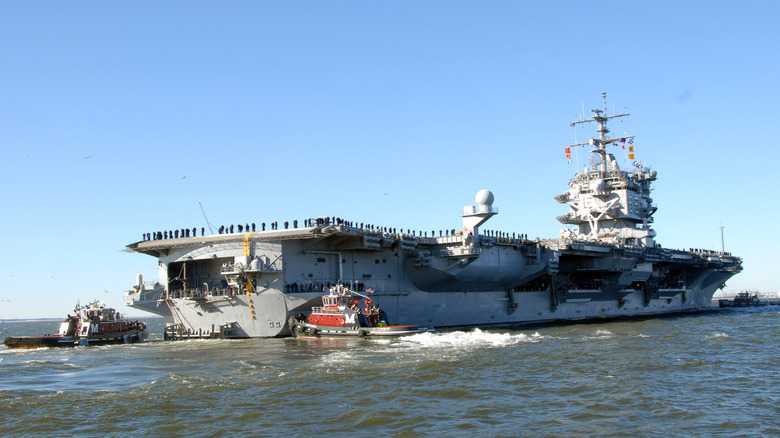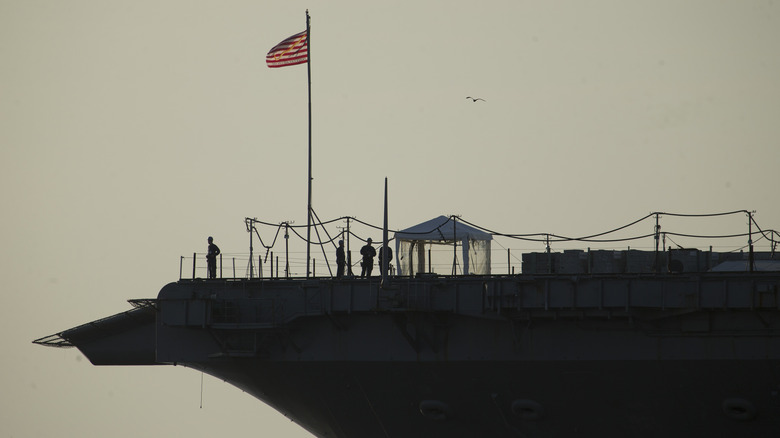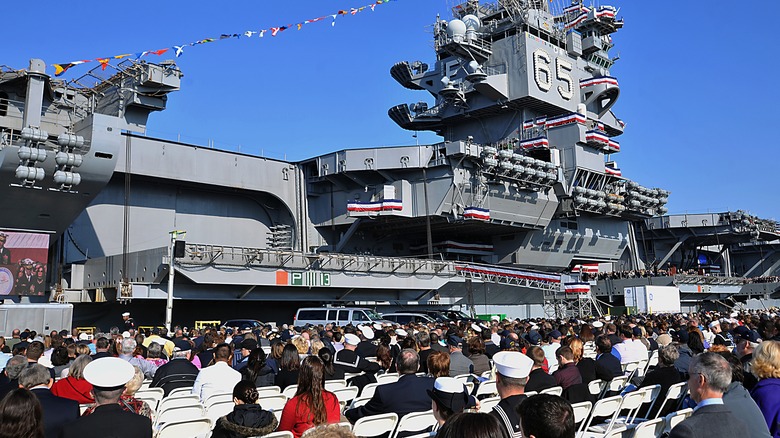Here's How The Navy Plans To Decommission The Nuclear USS Enterprise
Nuclear power is a real hot-button issue, and it continues to have enormous connotations both positive and negative. On the plus side, it's a cleaner source of energy, and one that requires far less space than the likes of wind turbines. NEI reports that a wind farm would need to be up to 360 times larger to work on the same scale as a nuclear facility.
On the other, of course, nuclear reactor accidents can be beyond devastating for the planet, and for a protracted period to boot. On top of this, nuclear power has produced some horrifying weapons. In utilizing the advantages of this energy source to power ships, then (it's perfect for long-term voyages on the likes of submarines as it untethers them from the need for regular refueling), it's vital to consider what happens to a nuclear-reactor-driven ship when it comes to the end of its service life. This is precisely the dilemma the U.S. Navy faces with its mighty USS Enterprise.
The Enterprise was powered not by one nuclear reactor, but eight of them. As a result, the task of safely and responsibly stripping it down is an unprecedented one, though it's vital to get a handle on the process before other nuclear aircraft carriers require similar treatment. Here's how the Navy plans to approach it.
The long life of the USS Enterprise
The formidable aircraft carrier USS Enterprise is, in its own way, a huge part of U.S. military history. It's not only large in terms of its sheer dimensions (it boasts a hangar bay with five acres of space spanning 1,123 feet long), but in terms of its role in modern combat.
This vast aircraft carrier arrived in November of 1961, and, within a year, it was deployed in Cuba during the Cuban Missile Crisis. Four years after being commissioned, it was a vital part of the Vietnam War, and, in the following decades, it saw combat in Iraq during Operations Desert Fox and, later, Enduring Freedom. For around five decades, the Enterprise was a part of many of the nation's military operations, finally being retired in 2012.
The aircraft carrier, USNI News reported in August 2022, has been located at HII Newport News Shipbuilding since it was decommissioned five years before. It seems that the time has come to officially take the Enterprise apart, but due to the nature of the work (it was the first nuclear-powered aircraft carrier in history after all), not to mention the scale of it, this is far from a straightforward task.
How the USS Enterprise will be taken apart
The disposal of nuclear waste, in any context or quantity, is a matter to be taken incredibly seriously. Accordingly, the Navy has considered every angle of the decommissioning of the Enterprise and what it would entail.
In its "Record of Decision for the Disposal of Decommissioned, Defueled Ex-Enterprise (CVN 65) and its Associated Naval Reactor Plants Environmental Impact Statement/Overseas Environmental Impact Statement," of August 2023, the Department of Defense noted that it sought numerous consultations looking into several options to determine the Enterprise's ultimate fate. A "No Action Alternative," it concluded, would incur continued maintenance costs for the unused ship while "only delay[ing] the ultimate permanent disposal of ex-Enterprise."
The document notes that the ultimate decision was that the ship will be transported to a contractor, to be fully taken apart. Portions that are free of nuclear material will be recycled where possible or simply (legally and responsibly) disposed of. The reactors will be split into small pieces in "several hundred containers that meet applicable Nuclear Regulatory Commission (NRC), Department of Transportation, and DOE transportation requirements."
USNI News adds that the Department of Energy Idaho National Laboratory is already the home of the fuel from those reactors. All in all, this was considered the most cost-effective and ethical option, with the navy's Pugent Sound facility already being so busy.


